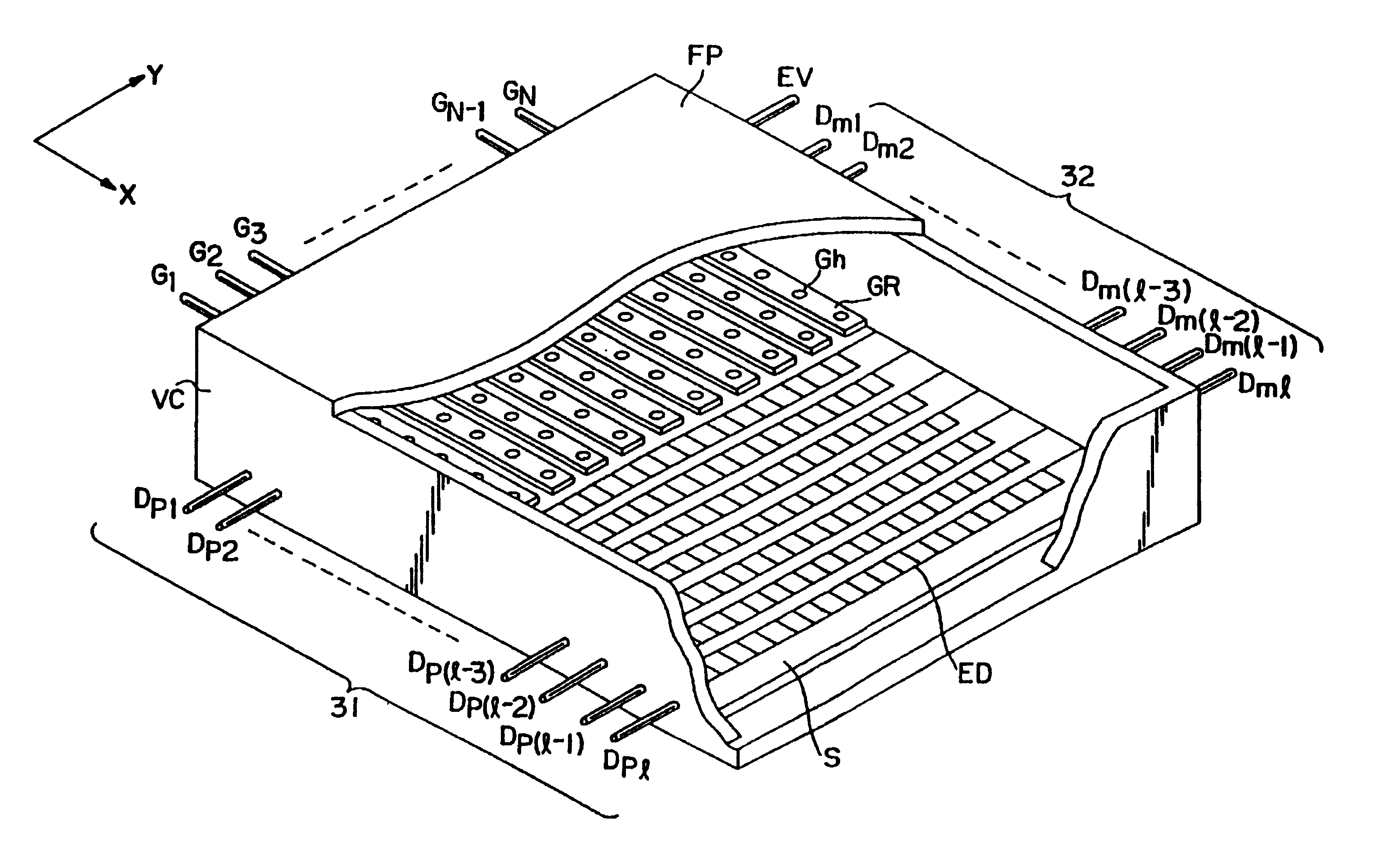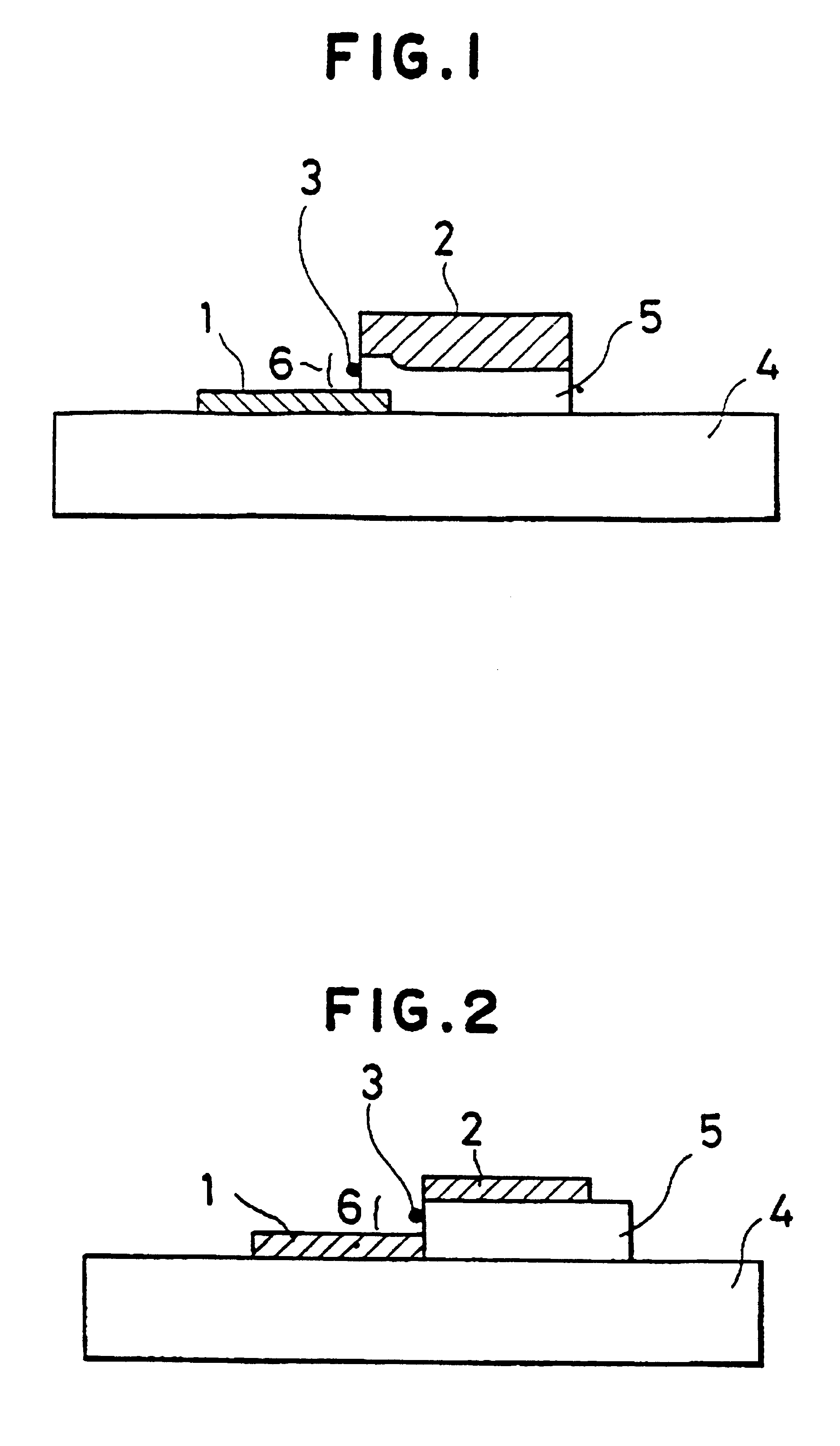Flat panel display including electron emitting device
- Summary
- Abstract
- Description
- Claims
- Application Information
AI Technical Summary
Benefits of technology
Problems solved by technology
Method used
Image
Examples
example 1
[0244]FIG. 3 (a), (b) is a flow sheet illustrating an example for a method of preparing the electron-emitting device of the present invention.
[0245]In FIG. 3(a), (b), the numeral 4 denotes a glass substrate; and 1, a nickel electrode of 500 angstroms thick.
[0246]SiO2 was vapor deposited to form an insulating layer 5a of 1,000 angstroms thick. Au was vapor deposited as an electron-emitting layer 3a to have a thickness of 500 angstroms, and an insulating layer 5b was also formed in the same manner as for 5a, thus bringing these three layers into lamination.
[0247]Then these were partly laminated on the electrode 1 as illustrated in FIG. 3 (a), along the pattern of the electrode 1, followed by patterning. Next, Ni was laminated as an electrode 2 with a film thickness of 5,000 angstroms.
[0248]As illustrated in FIG. 3 (b), the electrode 2 was subjected to patterning by usual photolithographic process along the patterns of the electrode 1, insulating layer 5a, electron-emitting layer 3a an...
example 2
[0251]In FIG. 4, the numerals 1 to 5 denote the same as in FIG. 3. In this figure, the numeral 8 denotes an intermediate layer, which is interposed between the insulating layer 5b and electrode 2 to contribute a multi-layer electrode. In the present Example, subsequent to the formation of the insulating layer 5b, a step to vapor-deposit LaB6 to a thickness of 1,000 angstroms followed by patterning was added to the preparation steps in Example 1. The electrode 2 was also formed by using Ni with a thickness of 5,000 angstroms as in Example 1.
[0252]Applying a voltage of 20 V between the electrode 2a and 2b of the device thus obtained, there was obtained emission of an electron beam 7 of 0.5 μA per 1 mm length of width of the electrode 2a in the direction vertical to the paper surface.
example 3
[0253]FIG. 6(a), (b) is a flow sheet illustrating an example for a method of preparing the electron-emitting device according to the second embodiment of the present invention. In FIG. 6 (a), (b), the numeral 4 denotes a glass substrate.
[0254]An insulating layer 5a was formed with SIO2 in 1,500 angstrom thickness; an electron-emitting layer 3a, with Pd in 250 angstroms thickness; and an insulating layer 5b, with SiO2 in 500 angstrom thickness, each of which layer was obtained by vacuum deposition and thereafter, as illustrated in FIG. 6 (a), etched to have a stepped shape to effect patterning. Next, electrodes 1 and 2 are deposited. The electrodes, as illustrated in FIG. 6 (b), are deposited on the insulating layer 5a and 8b and the stepped portion formed by the electron-emitting layer 3a with use of Ni with a thickness of 1,000 angstroms. In this occasion, generally the electrode 1 will not come into contact with the electron-emitting layer 3 if the thickness of the electrode is ma...
PUM
 Login to view more
Login to view more Abstract
Description
Claims
Application Information
 Login to view more
Login to view more - R&D Engineer
- R&D Manager
- IP Professional
- Industry Leading Data Capabilities
- Powerful AI technology
- Patent DNA Extraction
Browse by: Latest US Patents, China's latest patents, Technical Efficacy Thesaurus, Application Domain, Technology Topic.
© 2024 PatSnap. All rights reserved.Legal|Privacy policy|Modern Slavery Act Transparency Statement|Sitemap



